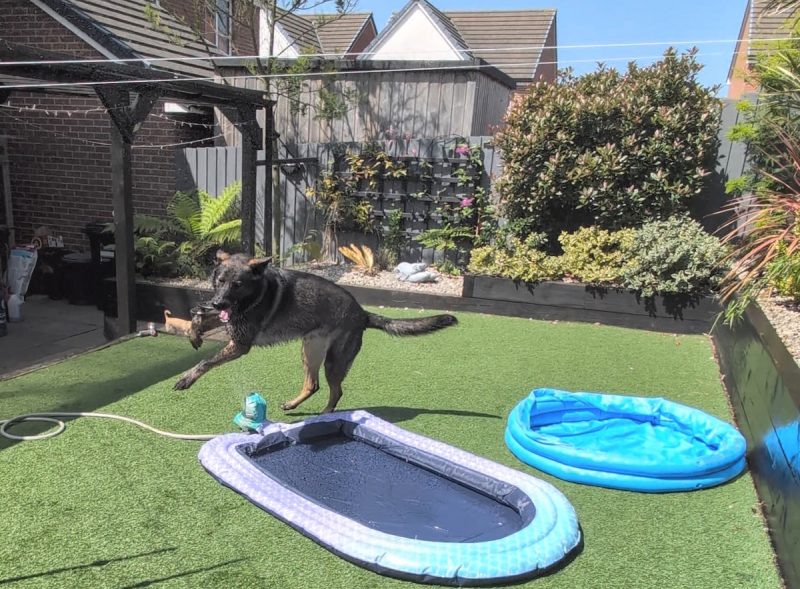Were you ready to take your dog on a walk, but the harness doesn’t fit? An easy walk harness teaches your dog not to pull during a walk while maintaining safety. However, there’s a slight learning curve to fitting the harness. It’s not too difficult, and with practice, you shouldn’t have any problems. Here’s how you do it.

Before You Begin
Fitting a dog harness is like buying a new belt. You can try to adjust it, but it won’t work unless you start with the correct size. An unfit harness is frustrating to deal with, and your dog could escape from the harness if you’re not careful. Manufacturers usually include sizing charts when their products are featured online, but some are more accurate than others.
The chart below can help you choose the most accurate harness size. Keep in mind that the weight ranges are only approximate. If your dog fits into two weight classes, go one size up.
| Size Chart | |||
| Size | Chest (1) | Girth (2) | Weight |
| Petite | 6″ to 7″ | 12″ to 16″ | Under 10 lbs. |
| Petite/Small | 8″ to 9″ | 13″ to 18″ | 10 to 15 lbs. |
| Small | 8.5″ to 11″ | 15″ to 21″ | 15 to 25 lbs. |
| Small/Medium | 11″ to 13″ | 19″ to 26″ | 20 to 30 lbs. |
| Medium | 12″ to 15″ | 21″ to 32″ | 25 to 50 lbs. |
| Medium/Large | 14″ to 18″ | 24.5″ to 34″ | 40 to 65 lbs. |
| Large | 16″ to 21″ | 27″ to 40″ | 65 to 95 lbs. |
| Extra Large | 17.5″ to 23.5″ | 32″ to 50″ | 90+ lbs. |
*chart from PetSafe.net

How to Put on an Easy Walk Dog Harness
1. Identify the Straps
An easy walk harness has three straps: the chest, belly, and shoulder straps.
The chest strap has the Martingale loop. Unlike other leashes, the D-ring on the Martingale loops rests on the chest instead of the spine.
The belly strap rests on the belly, behind the front legs. It is typically a different color than the other straps.
The shoulder strap is the top strap. It will rest across the dog’s shoulders.

2. Fit the Shoulder Strap
Place the harness on your dog. Adjust the shoulder strap so the two O-rings rest above and behind your dog’s shoulders.
3. Fit the Belly Strap
Adjust the belly strap so the harness fits snugly against your dog. The harness should be tight but not dig into the armpit area. You should be able to comfortably fit two fingers between the strap and your dog.

4. Check the Fit
Ensure that the chest and shoulder straps stay put while your dog walks. If they rotate, tighten the harness until they stop.
5. Fit the Chest Strap
Make sure the chest strap rests low on your dog’s chest and not across the throat. This strap will feel looser than the other straps and should rest horizontally across the breastbone with the D-ring in the center for the best fit. Two adjusters on the chest strap make this possible.
6. Check the Final Fit
Look at the final fit once you’ve modified the harness to fit your dog. The harness should look like a sideways T.
If the harness resembles a sideways Y, try to adjust it until it looks more like a T. You can probably loosen the chest strap, depending on the model. However, if you can’t, the harness is too small.


Fitting & Chafing Tips
- Dogs sometimes tense their bodies during a fitting, so check the adjustments one more time after a walk.
- A heavy leash can cause the harness to drag. The best leash is 4 to 6 feet long and has a lightweight clasp.
- Do not use a retractable leash; the tension can cause the dog to pull and wear down the chest strap.
- Do not use a coupler dog leash since the tension from the other dog can confuse your dog.

Summary
An easy walk dog harness differs from other harnesses, and adjusting the straps will take a couple of tries before you get the hang of it, but it won’t take long. Pretty soon, you and your dog will be exploring the great outdoors.
Featured Image Credit: knelson20, Shutterstock



















